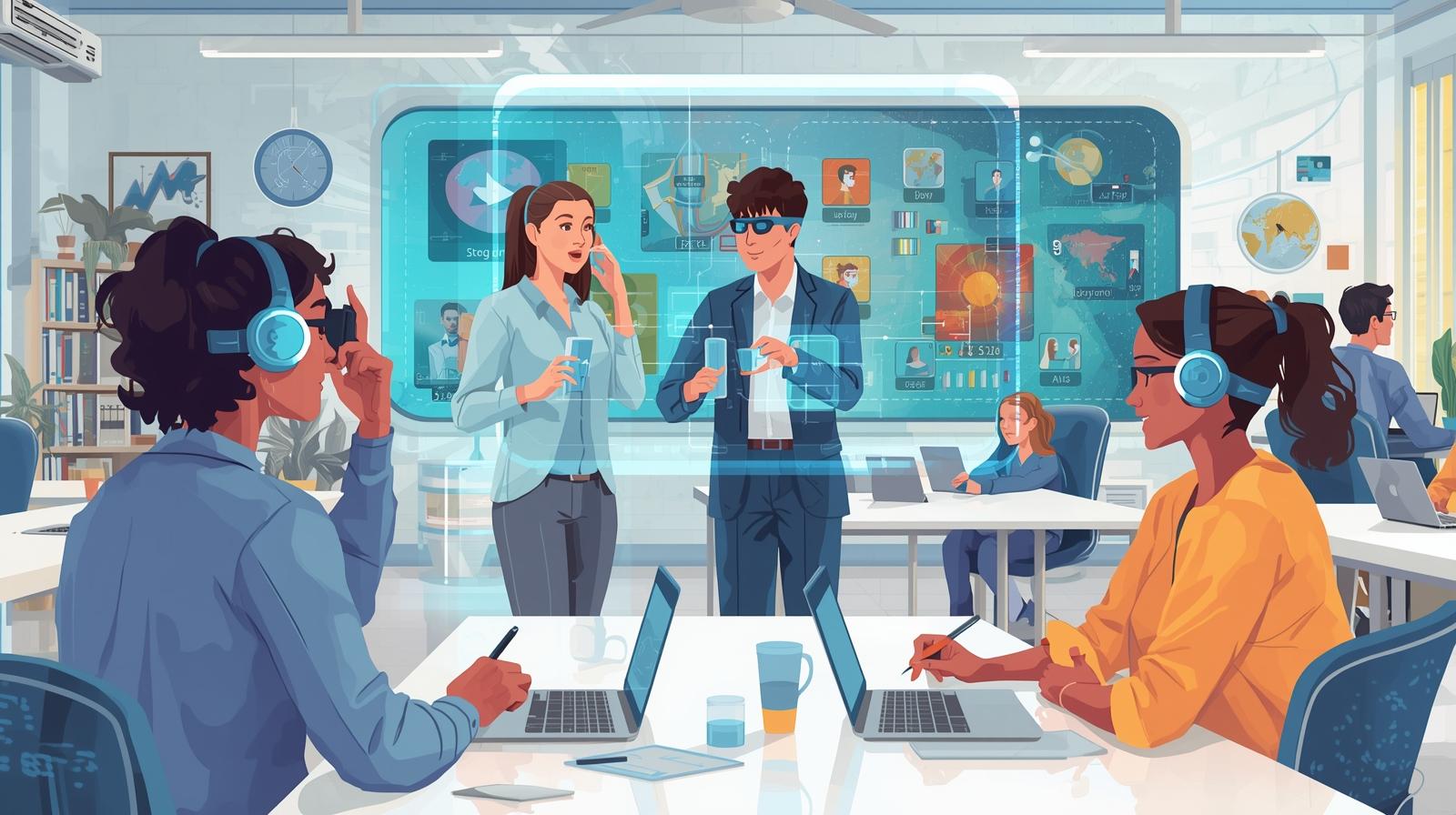The landscape of education is perpetually evolving, shaped by technological advancements that promise to enhance how we teach and learn. From the humble overhead projector to interactive whiteboards and one-to-one laptop programs, each wave of innovation has sought to make education more engaging, accessible, and effective. Today, we stand on the precipice of the next major shift, driven by a more intimate form of technology: wearables. The integration of Wearable Technology in Education is moving beyond science fiction to become a tangible reality, offering unprecedented opportunities to personalize learning, foster engagement, and bridge the gap between theoretical knowledge and real-world application. This article delves deep into this emerging phenomenon, exploring its applications, benefits, challenges, and future potential.
The wearable technology market size was estimated at USD 70.30 billion in 2024 and is predicted to increase from USD 84.5 billion in 2025 to approximately USD 152.82 billion by 2029, expanding at a CAGR of 16.8% from 2024 to 2029.

Understanding Wearable Technology in the Educational Context
Wearable Technology in Education refers to any electronic device that can be worn on the body—often as an accessory or integrated into clothing—and is used to enhance the teaching and learning process. Unlike a tablet or laptop that is used intermittently, wearables are characterized by their constant presence and connectivity, providing a continuous stream of data and interaction. This category includes a wide array of devices such as smartwatches, fitness trackers, augmented reality (AR) smart glasses, and even biometric sensors. The core premise is to create a more immersive, data-informed, and interactive learning environment that responds to the individual needs of each student.
The Multifaceted Applications of Wearables in the Classroom
The potential uses for Wearable Technology in Education are vast and varied, spanning different subjects, age groups, and learning objectives. Their application is not about replacing teachers but empowering them with better tools and insights.
Augmented Reality (AR) Glasses for Immersive Learning
AR glasses, like Microsoft HoloLens or simpler smartphone-based alternatives, overlay digital information onto the real world. In history class, students can witness historical events unfold around them. In biology, they can take a detailed, walking tour through a human heart. This hands-on, visual learning style moves students from passive recipients of information to active explorers, dramatically improving comprehension and retention of complex subjects.
Smartwatches and Fitness Trackers in Physical Education
In PE and health classes, these devices are a natural fit. Students can monitor their heart rates, count steps, track activity levels, and analyze sleep patterns. This transforms physical education from a simple activity period into a data-driven lesson on personal health, physiology, and goal setting. Teachers can use aggregated, anonymized data to design more effective and inclusive fitness programs.
Biometric Sensors for Measuring Student Engagement
Advanced wearables can measure physiological indicators like galvanic skin response (GSR) or electroencephalography (EEG) to gauge emotional and cognitive states. This biofeedback can help educators understand when a student is focused, frustrated, or bored. While ethically complex, this data can be used to adjust teaching methods in real-time or identify students who may need additional support, moving towards a truly responsive classroom.
Location Trackers for Enhanced Field Trips and School Safety
Devices with GPS or RFID capabilities can make field trips more interactive and secure. Students can receive location-specific information on a nature trail or in a museum, turning a simple tour into a guided, educational scavenger hunt. Furthermore, these devices can help teachers keep track of all students, ensuring safety in crowded environments.
Translation Devices for Language Learning and Inclusion
Wearable earpieces that provide real-time translation can break down language barriers for ESL (English as a Second Language) students, allowing them to participate more fully in classroom discussions without constant intervention from a translator. This fosters a more inclusive environment and accelerates language acquisition.
Download PDF Brochure @ https://www.marketsandmarkets.com/pdfdownloadNew.asp?id=983
The Tangible Benefits: Why Schools are Exploring Wearables
The adoption of Wearable Technology in Education is driven by a compelling set of advantages that address long-standing challenges in the educational sector.
Personalized and Differentiated Learning Pathways
This is arguably the most significant benefit. Wearables provide a continuous stream of data on a student’s performance, engagement, and even well-being. Adaptive learning software can use this data to automatically adjust the difficulty of tasks, recommend specific resources, or provide targeted feedback. This creates a custom-tailored educational experience that moves at the perfect pace for each individual learner, catering to both those who need more help and those who are ready to advance.
Increased Student Engagement and Motivation
The interactive and gamified nature of many wearable applications makes learning fun. Earning badges for completed activities, competing in class step challenges, or interacting with 3D holograms transforms education from a chore into an engaging adventure. This heightened engagement directly correlates with improved attendance, participation, and overall academic achievement.
-
Gamification: Turning lessons into interactive games with instant feedback.
-
Hands-on Experience: Using AR/VR for practical, memorable learning.
-
Instant Feedback: Allowing students to track their own progress in real-time.
Improved Feedback and Assessment for Educators
Traditional assessments like tests and quizzes provide a snapshot of learning at a single point in time. Wearables offer continuous assessment. A teacher can see that a majority of the class’s attention waned during a specific lesson segment or that a particular student consistently shows signs of anxiety during math. This allows for formative assessment that informs teaching strategies and provides help long before a high-stakes exam.
Fostering Collaboration and Social Learning
Many wearable tech activities are designed to be collaborative. Students might work together to solve an AR-based puzzle or share and compare data from a group science experiment. This encourages communication, teamwork, and peer-to-peer learning, which are critical 21st-century skills.
Supporting Students with Special Needs
Wearable Technology in Education has profound implications for special education. Devices can provide haptic feedback for students with hearing impairments, offer step-by-step prompts for those with autism to navigate social situations, or monitor the stress levels of students with anxiety disorders, alerting a teacher or counselor when intervention is needed.

Navigating the Significant Challenges and Concerns
Despite its promise, the widespread implementation of Wearable Technology in Education is not without its serious hurdles. Addressing these concerns is critical for ethical and successful adoption.
Data Privacy and Security
This is the paramount concern. Wearables collect vast amounts of highly personal, biometric data. Questions about who owns this data, where it is stored, how it is used, and who has access to it are critical. Schools must have robust cybersecurity measures and clear, transparent policies that comply with regulations like FERPA and COPPA to protect students from data breaches and misuse.
High Cost and Digital Equity
The initial investment in hardware, software, infrastructure, and teacher training can be prohibitive for many school districts. This raises serious concerns about the digital divide, where affluent schools benefit from cutting-edge technology while underfunded schools fall further behind, exacerbating existing educational inequalities.
Potential for Distraction
A smartwatch buzzing with notifications from social media or messages can easily pull a student’s attention away from the lesson. Educators will need to develop clear usage policies and potentially implement classroom management modes on the devices to minimize distraction rather than amplify it.
Teacher Training and Curriculum Integration
Technology is only as effective as the person using it. Teachers require significant professional development to not only use the devices but to effectively integrate them into the curriculum in a meaningful way that aligns with learning objectives. Without proper training, these expensive tools risk becoming little more than digital toys.
Durability and Maintenance
Classrooms are active, sometimes chaotic, environments. Wearable devices must be durable enough to withstand daily use by children. Schools also need to plan for maintenance, repairs, updates, and eventual replacement, adding to the total cost of ownership.
The Future Trajectory of Wearable Technology in Education
The future of Wearable Technology in Education is incredibly promising, evolving towards even more seamless and powerful integration. We can anticipate the development of more affordable and durable devices designed specifically for classroom use. Artificial Intelligence (AI) will play a larger role, with wearables acting as a data collection point for AI systems that provide deep, predictive analytics on student learning patterns. Furthermore, we will see a stronger focus on “unnoticeable” wearables integrated into clothing or accessories, making the technology even less intrusive. The ultimate goal is a learning ecosystem that is adaptive, inclusive, and responsive, where technology empowers educators and unlocks every student’s full potential by understanding their unique learning journey.
The journey of integrating Wearable Technology in Education is just beginning. It presents a paradigm shift from one-size-fits-all instruction to a model of hyper-personalized, immersive, and data-driven learning. While the challenges of cost, privacy, and implementation are substantial, they are not insurmountable. With careful planning, robust ethical guidelines, and a focus on pedagogical value over technological novelty, wearables have the potential to democratize personalized education and create more engaging, effective, and inclusive classrooms. The future of learning will not be defined by technology alone, but by our ability to harness it wisely to inspire the next generation of thinkers, creators, and leaders.
Explore In-Depth Semiconductor & Electronics Market Research:
https://www.marketsandmarkets.com/semiconductorand-electonics-market-research-87.html
FAQs
Q1: Is Wearable Technology in Education safe for children?
A1: Physically, most consumer wearables are designed to be safe. However, safety concerns primarily revolve around data privacy and potential exposure to radiation (which is minimal in most devices). Schools must choose vetted products and implement strict data security protocols to ensure student safety.
Q2: Doesn’t this technology create an even larger gap between rich and poor schools?
A2: It certainly has the potential to, which is a major ethical concern. Addressing this requires concerted effort from policymakers and edtech companies to create funding models, subsidies, and affordable solutions specifically aimed at low-income districts to prevent a widening digital divide.
Q3: How can teachers be convinced to use this technology?
A3: Successful adoption hinges on demonstrating clear pedagogical benefits, not just the technology’s “cool factor.” Providing comprehensive training, ongoing technical support, and showcasing success stories from other educators are crucial steps in gaining teacher buy-in.
Q4: What is the simplest way to start integrating wearables into a school?
A4: Starting small with a pilot program is often best. Using basic fitness trackers in a PE department or a single set of AR glasses for a science class allows a school to test the waters, understand the implications, and develop best practices before scaling up to a larger, more expensive rollout.
Q5: Can wearable technology replace teachers?
A5: Absolutely not. The role of wearable technology is to augment and assist teachers, not replace them. The human element of teaching—mentorship, inspiration, empathy, and complex social interaction—cannot be replicated by a machine. Wearables provide teachers with better tools and data to do their jobs more effectively.
See The Latest Semiconductor Reports:
Radiation Hardened Electronics Market Size, Share & Trends : https://www.marketsandmarkets.com/Market-Reports/radiation-hardened-electronics-market-44047967.html
Smart Appliances Market Size, Share & Trends : https://www.marketsandmarkets.com/Market-Reports/smart-appliances-market-8228252.html
Ultra-low-power Microcontroller Market Size, Share & Trends : https://www.marketsandmarkets.com/Market-Reports/ultra-low-power-microcontroller-market-206772623.html
Quantum Computing Market Size, Share & Trends : https://www.marketsandmarkets.com/Market-Reports/quantum-computing-market-144888301.html
Cold Chain Monitoring Market Size, Share & Trends : https://www.marketsandmarkets.com/Market-Reports/cold-chain-monitoring-market-161738480.html
Printed Electronics Market Size, Share & Trends : https://www.marketsandmarkets.com/Market-Reports/printed-electronics-market-197.html
